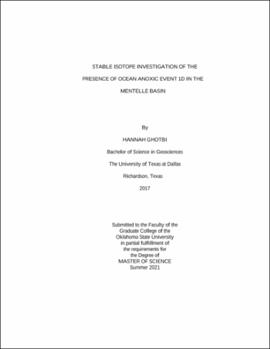| dc.contributor.advisor | Quan, Tracy | |
| dc.contributor.author | Ghotbi, Hannah | |
| dc.date.accessioned | 2022-01-09T19:37:52Z | |
| dc.date.available | 2022-01-09T19:37:52Z | |
| dc.date.issued | 2021-06 | |
| dc.identifier.uri | https://hdl.handle.net/11244/333644 | |
| dc.description.abstract | Many studies investigating Ocean Anoxic Events (OAEs) used samples from areas that are around lower paleo latitudes typically in the Northern Hemisphere, mostly around the Atlantic Ocean and former Western Interior Seaway. OAE 1d (Albian-Cenomanian boundary) is suspected to be a global event, but paleoredox data from the Southern Hemisphere are limited. The samples used in this study were collected from two Holes, U1513C and U1516C, drilled in the Mentelle Basin off the southwest coast of Australia during International Ocean Discovery Program (IODP) Expedition 369. For Hole U1513C, the redox state is variable. The stable nitrogen isotope values of acidified samples (d15Nacidified) for U1513C range from -1.2 0/00 to 2.2 0/00. The d15Nacidified data suggest that an interval at Hole U1513C displays a trend of a possible OAE 1d occurrence with d15Nacidified values. The trend is more negative d15Nacidified values that are possibly anoxic, flanked by more positive d15Nacidified values indicate suboxic conditions. This hypothesized trend for d15Nacidified values for OAE 1d that if seen with other proxies such as d13Corg and TOC would confirm that OAE 1d occurred at this interval. At Hole U1516C, the data indicate that the redox state is not as variable as at Hole U1513C. For Hole U1516C, the change in d15Nacidified values is generally less than 1 0/00 and ranges from -1.2 to 0.6 0/00 The lack of change across this Hole and a large hiatus in a possible OAE 1d interval do not aid the interpretation of the d15Nacidified values. The redox state at this site could be oxic or anoxic due to low d15Nacidified values at this Hole, but oxic conditions are more likely, due to low organic matter concentrations. The area was influenced by rifting from the breakup of the Indian, Australian, and Antarctic plates. The depositional environment of the Mentelle Basin at the time of OAE 1d is a subsiding basin with a potential depth of 600 - 2000 meters with deposition of claystone indicating a low energy environment. The Mentelle Basin has been shown to have had restricted water circulation. All of these factors indicate possible anoxia could have occurred during OAE 1d. Without at least one other proxy such as d13Corg, we cannot confidently constrain the redox state and cannot confirm OAE 1d's occurrences at either Hole. A much-needed addition to this study would be d13Corg and TOC measurements, as is common for OAE investigations. | |
| dc.format | application/pdf | |
| dc.language | en_US | |
| dc.rights | Copyright is held by the author who has granted the Oklahoma State University Library the non-exclusive right to share this material in its institutional repository. Contact Digital Library Services at lib-dls@okstate.edu or 405-744-9161 for the permission policy on the use, reproduction or distribution of this material. | |
| dc.title | Stable isotope investigation of the presence of ocean anoxic event 1d in Mentelle Basin | |
| dc.contributor.committeeMember | Riedinger, Natascha | |
| dc.contributor.committeeMember | Grammer, Michael | |
| osu.filename | Ghotbi_okstate_0664M_17226.pdf | |
| osu.accesstype | Open Access | |
| dc.type.genre | Thesis | |
| dc.type.material | Text | |
| dc.subject.keywords | australia | |
| dc.subject.keywords | mentelle basin | |
| dc.subject.keywords | oae | |
| dc.subject.keywords | ocean anoxic event | |
| dc.subject.keywords | redox | |
| dc.subject.keywords | stable nitrogen isotopes | |
| thesis.degree.discipline | Geology | |
| thesis.degree.grantor | Oklahoma State University | |
